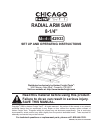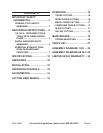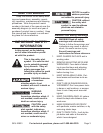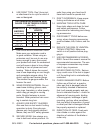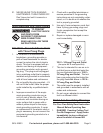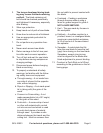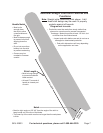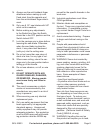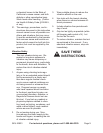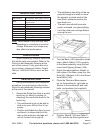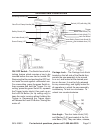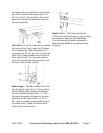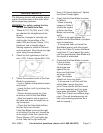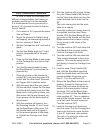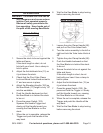SKU 42933 For technical questions, please call 1-800-444-3353. Page 8
Always use the anti-kickback nger 14.
attachment when making rip cuts.
Feed stock from the opposite end
from the anti-kickback nger attach-
ment.
Only use 8 1/4” saw blades with 5/8” 15.
arbor on this machine.
Before making any adjustments 16.
to the Radial Arm Saw, the Switch
should be in the OFF position and the
Switch locked OFF.
Lock the carriage arm in place before 17.
lowering the saw blade. Otherwise,
when the saw blade touches the
stock, it may draw itself backward
(with you) into the cutting area.
Do not cut more than one piece of 18.
stock at a time, for any type of cut.
When cross cutting, return the car-19.
riage arm to the rear position before
letting go of the Handle.
Do not use abrasive, cut off, or wire 20.
wheels.
DO NOT OPERATE WITH ANY 21.
GUARD DISABLED, DAMAGED,
OR REMOVED. Moving guards
must move freely and close in-
stantly.
The use of accessories or attach-22.
ments not recommended by the
manufacturer may result in a risk of
injury to persons.
When servicing use only identical 23.
replacement parts.
Only use safety equipment that has 24.
been approved by an appropriate
standards agency. Unapproved
safety equipment may not provide
adequate protection. Eye protection
must be ANSI-approved and breath-
ing protection must be NIOSH-ap-
proved for the specic hazards in the
work area.
Industrial applications must follow 25.
OSHA guidelines.
Maintain labels and nameplates on 26.
the tool. These carry important safety
information. If unreadable or miss-
ing, contact Harbor Freight Tools for a
replacement.
Avoid unintentional starting. Prepare 27.
to begin work before turning on the
tool.
People with pacemakers should 28.
consult their physician(s) before use.
Electromagnetic elds in close prox-
imity to heart pacemaker could cause
pacemaker interference or pacemak-
er failure.
WARNING: Some dust created by 29.
power sanding, sawing, grinding, drill-
ing, and other construction activities,
contains chemicals known [to the
State of California] to cause cancer,
birth defects or other reproductive
harm. Some examples of these
chemicals are:
• Lead from lead-based paints
• Crystalline silica from bricks and ce-
ment or other masonry products
• Arsenic and chromium from chemi-
cally treated lumber
Your risk from these exposures var-
ies, depending on how often you do
this type of work. To reduce your
exposure to these chemicals: work in
a well ventilated area, and work with
approved safety equipment, such as
those dust masks that are specially
designed to lter out microscopic
particles. (California Health & Safety
Code § 25249.5, et seq.)
WARNING: Handling the cord on 30.
this product will expose you to lead,



